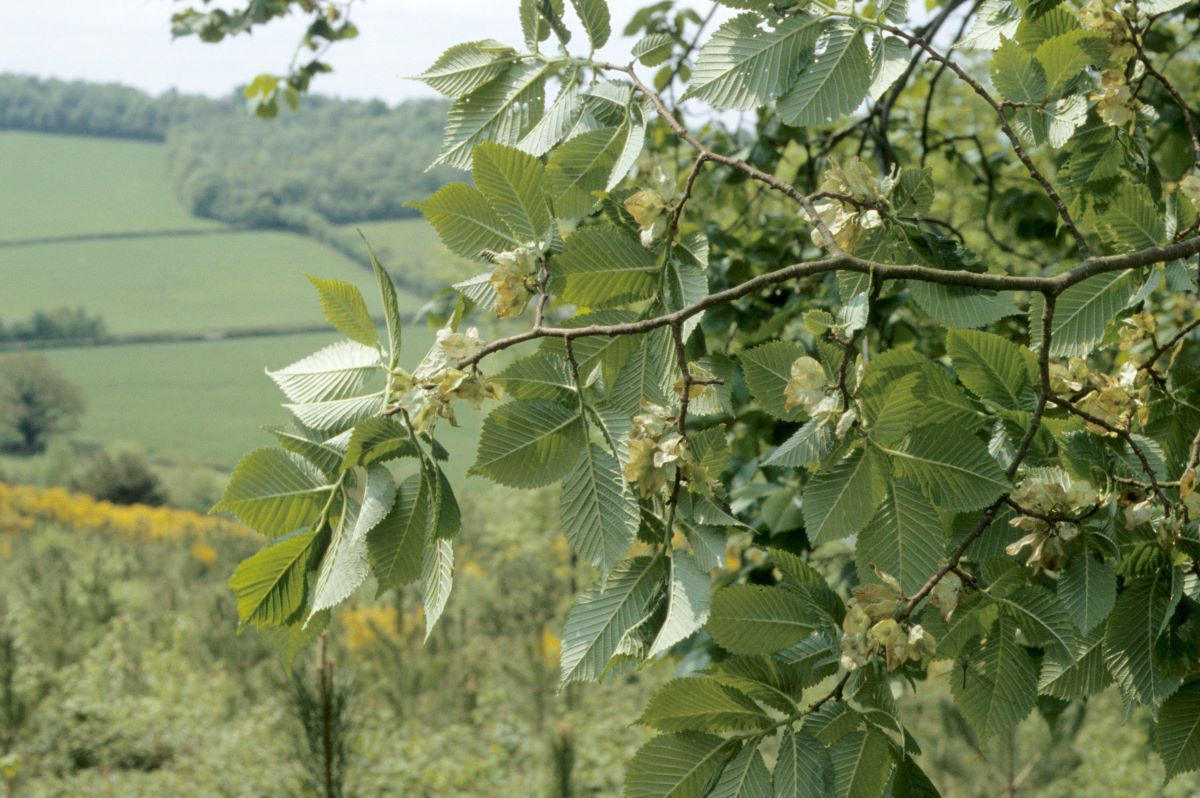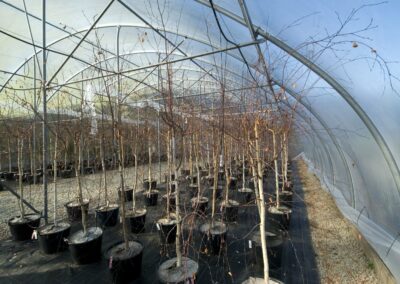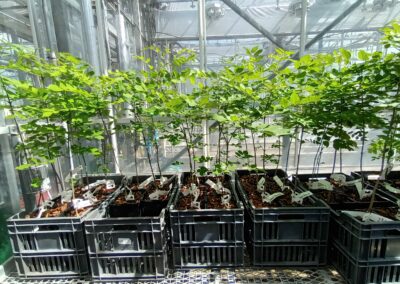Mapping the distribution and diversity of UK elm
Project leads Dr Joan Webber I Forest Research; Prof. Richard Buggs I Royal Botanic Gardens, Kew
Lead organisation Royal Botanic Gardens, Kew
Collaborators Conservation Foundation; Butterfly Conservation
Project status Complete (March 2022 – April 2025)
Project funding £226,000
Research outcomes Recovery I Resistance

Context
Since 1970 Dutch elm disease (DED) has killed approximately 100 million elm (Ulmus) trees in Britain. It is caused by the non-native fungal pathogen Ophiostoma novo-ulmi, which is spread by two species of bark beetle that feed on healthy elms and breed in dying elms. Today the UK landscape has few mature elms although there are some rare old survivors, possibly with natural resistance.
Elms support many invertebrates, including the white-letter hairstreak butterfly and white-spotted pinion moth. They are are fast-growing, fix carbon into long-lasting timber valuable for building and furniture making; the timber does not rot in water and has uses in many socio-cultural practices.
Across the UK, young elms regenerate constantly as small trees, surviving 10-20 years before succumbing to DED. The availability of regenerating elms allows the smaller beetle to breed successfully. The larger of the two beetles, which spreads the fungus more effectively, requires the thicker bark of larger elms to reproduce successfully so its population numbers may have declined, but this has not been accurately studied.
European elms have little resistance to Ophiostoma novo-ulmi, but breeding programmes in Europe have crossed resistant Asiatic elms with European species to produce resistant cultivars, although none resemble the familiar field elm (Ulmus minor) or native wych elm (Ulmus glabra). A recent development is the availability of resistant field elm clones, propagated from trees that have survived DED in Spain. Private individuals have already planted ‘resistant’ elm cultivars from continental programmes and cloned older elms which have survived the DED epidemic in Britain, and there is a growing interest in restoring elm to the landscape in this way.
Research aims and objectives
Aim
The aim is to understand how resistant elms could perform over the long-term against changing DED pressures.
Objectives
- Survey the genomic diversity of UK elms including both planted ‘resistant’ elms and older natural survivors.
- Build a single accessible database with details of resistant elm plantings and older survivor elms in Britain and map their distribution.
- Evaluate the durability of planted resistant elm cultivars under DED pressure.
- Establish the presence and frequency of the two vector beetle species.
- Use the study findings to underpin future efforts to return mature elms to the landscape.
This project lays the foundations for elm restoration in Britain and future research on elms. We will gather and consolidate what is currently dispersed information from a range of sources to provide a resource and reference point for those wishing to select and plant resistant elms in the future.
Data will be gathered from several field sites. We will identify which beetles are present based on the larval galleries remaining in the bark used for breeding and live beetles if any are collected. The durability of resistance to elms exposed to the beetles will be assessed by evidence of beetle feeding apparent on resistant trees, and whether this is associated with symptom development.
The project will benchmark the genetic diversity of elms in Britain and safeguard survey data on mature elms collected over 40 years by the Conservation Foundation.
DNA will be extracted from samples of both ‘resistant’ and ‘susceptible’ elms across the UK, and the whole genomes will be sequenced. These sequences will be used to identify genetic variations across the sampled populations and to find different ancestral groups. The genetic differences between resistant and susceptible elms will add important information to the selection of trees for restoration efforts.
Expected outcomes
- A database detailing resistant elm collections and their performance under growing conditions in Britain.
- Insights into the genomic diversity of British elms.
- Recommendations to support the return of mature elms to the landscape.
Further resources linked to this project
Watch some short talks on this project
In this talk, Dr Joan Webber (Forest Research) presents research on beetle behaviour and the performance of Dutch elm disease-resistance elms.
This talk was part of the ‘Elm Research Update’ webinar originally broadcast by the Centre for Forest Protection on 18 March 2025.
In this talk, Professor Richard Buggs (Royal Botanic Gardens, Kew) presents research on the genomics of UK elm.
This talk was part of the ‘Elm Research Update’ webinar broadcast by the Centre for Forest Protection on 18 March 2025.

A wych elm in Kew Gardens (photo credit: M. Vatanparast)
Glossary & Key Terms
Cultivars
A specific variety of tree that has been selected and cultivated for particular desirable traits.
Dutch elm disease (DED)
Dutch elm disease is a highly destructive disease of several species of elm (trees in the Ulmus genus). It is caused by two related fungi, Ophiostoma novo-ulmi and Ophiostoma ulmi, although almost all cases are now caused by O. novo-ulmi. The fungus is spread from tree to tree by elm bark beetles. It has killed tens of millions of elm trees in the United Kingdom since O. novo-ulmi was accidentally introduced, probably during the 1960s. For more information, see Dutch elm disease (Ophiostoma novo-ulmi) – Forest Research.
Elm (Ulmus)
A historically significant and culturally iconic tree species in the British landscape, which has suffered major decline due to disease, particularly Dutch elm disease caused by the fungus Ophiostoma novo-ulmi.
Field elm (Ulmus minor)
One of the two native elm species in Britain (the other being wych elm, Ulmus glabra). A species of elm tree which was once widespread across the UK landscape. It is one of the native European elm species that has been heavily affected by Dutch elm disease (DED).
Genetic diversity
Variation in genetic traits within a species or population.
Genome
The complete set of genetic material in an organism. It includes all of the organism’s DNA, which contains the instructions needed for growth, development, functioning, and reproduction.
Genome sequencing
The process of determining the complete DNA sequence of a tree’s genome. This includes identifying the order of all the nucleotides (A, T, C, and G) that make up its genetic material.
Genomic diversity
The variation found across the entire genome of individual trees within a species or population.
Larval galleries
Tunnels chewed through the wood by the beetle larvae.
Ophiostoma novo-ulmi
The fungus that causes Dutch elm disease (DED). It invades and blocks the water-conducting systems of trees. This results in the wilting and death of the tree. For more information, see Dutch elm disease: Symptoms and Diagnosis – Forest Research.
Pathogen
An organism or agent that can cause disease. Pathogens include viruses, bacteria, fungi, and protists. They can infect a wide range of hosts, including plants and animals.
Vector
An organism that transmits a pathogen, disease, or parasite from one animal or plant to another.
Wych elm (Ulmus glabra)
One of the two native elm species in Britain (the other being field elm, Ulmus minor). It is indigenous to the UK and has historically been a common part of the British landscape, especially in upland and northern areas. Like other European elms, wych elm is highly vulnerable to the fungal pathogen Ophiostoma novo-ulmi, which causes Dutch elm disease that has devastated elm populations since the 1970s.
Share this project on social media
Related Projects
Our Partners
Social media
Explore
Newsletter
Contact
© 2022 Centre for Forest Protection. All rights reserved.

